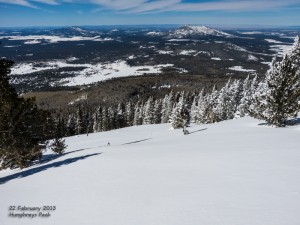Here is another image from early April showing both Comet PanSTARRS and M31 (Andromeda Galaxy). The winds were much lighter on this evening allowing for a smooth and reflective water surface.

The show continues with Comet C/2011 L4 (PanSTARRS) in the evening sky. Although it has grown dimmer — substantially so — in the past few weeks it is still easily visible in the northwestern twilight sky with a pair of binoculars. But it helps if you know exactly where to look.
For the next several nights, Comet PanSTARRS will be approaching M31 (also known as Andromeda Galaxy). Knowing where to find M31 it then becomes easy to look for the comet. Scanning the skies during twilight I was able to locate M31 with the binoculars then locked the position on the tripod. I swapped out the binoculars and replaced them with the camera.

Meanwhile, the zodiacal light has been quite remarkable this spring. This light is the result of the sun lighting up particles located in the ecliptic plane — the same plane in which the moon, sun, and planets move across the sky. The small size of many of the particles results in strong forward scattering so the brightest area is closest to the sun with the light fading above the horizon.

The zodiacal light was spectacular last night owing to exceptionally clear skies, no moon, and little or no nearby light pollution. After shooting the comet and M31 for some time I turned the camera more westward to capture this light. Sitting atop the triangle of light is the cluster of stars known as the Pleiades.
Over the next several evenings the comet will approach M31 so that they appear to overlap — although there is the mere distance of 2.5 million light years separating them.
Just a few days ago Comet PanSTARRS became visible to observers in the Northern Hemisphere. Today, the comet was located very near the 30h-old crescent moon making a striking pair of objects in the western twilight sky.


Tomorrow the moon will be higher in the sky with the comet below. Another photo opportunity!
The anticipation has been building for many months as observers in the northern Hemisphere have waited for their first view of Comet C/2011 L4 PanSTARRS (Wikipedia; EarthSky). The comet has been visible to observers in the southern hemisphere for quite some time and the photographs have been impressive.

The comet made its closest approach to the sun today (10 March 2013) and has been visible in the northern hemisphere for the past day or two (or three) but has been so close to the sun that it was difficult to see. Today there was enough separation between the comet and the sun that it could be seen about 30 minutes after sunset when the sky had darkened enough. But because it is still so close to the sun it set shortly after that so there was only a short viewing period. This should get better over the next few days and weeks as its orbit back out into the solar system takes it farther from the sun.

The next best photo opportunity will be on 12 March 2013 when the crescent moon will pass close to the comet.
After a few days of overcast skies and snow the weather has finally improved. With sunny skies and light winds, Friday was a good day to do some back country skiing. Our original destination was near Forest Road 794 at about 8000 feet elevation. We were disappointed to find that even at these elevations much of the snow pack was lost a few weeks ago during the warm winter storm that brought rain to the area. So we went with our backup plan and drove up Snowbowl Road to the base of the ski area. We skied across the lower slopes to the Humphreys Peak Trail and began our climb — eventually leaving the trail and traveling through the trees to some great ski terrain.

Our first stop was the area known as “Flying Dutchman.” Enough snow had fallen in the past few weeks to finally cover most (but not all) of the rocks. We followed an uphill track and eventually caught up to some acquaintances that we had not seen in a few years. After a few minutes of chatting, they headed downhill while we continued up to the site of the WWII bomber wreck — located just below tree line. The snow was very good — but still a few rocks were poking up through the snow (or lurking just below!) to catch and damage ski bases.

We skied down across the bomber site and then into the trees returning to the top of Flying Dutchman. This is always a lot of fun as it is moderately-pitched, wide-open terrain with plenty of vertical descent from top to bottom. And, yes, we hit a few more rocks.

Finally, back into the trees and down the narrow Humphreys Trail — which can feel a bit like a bobsled run when it gets hard and icy. But today the snow was good.